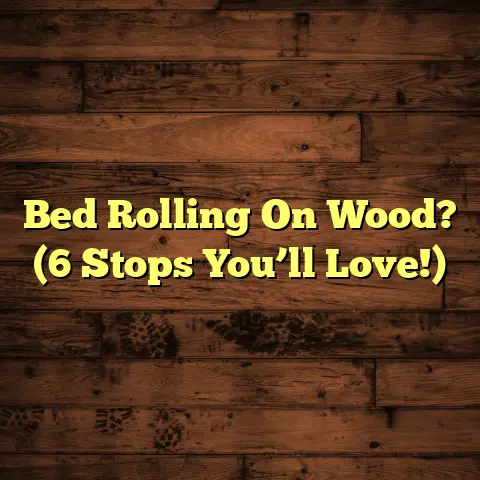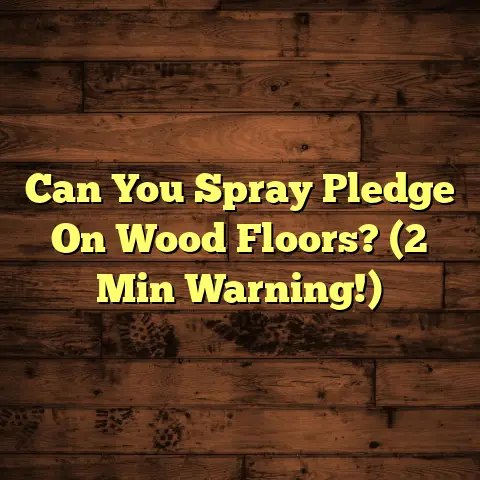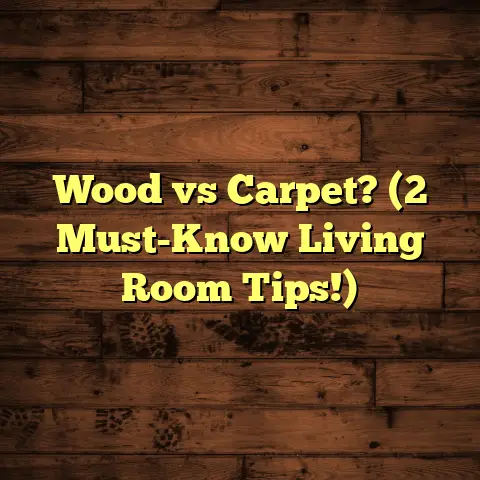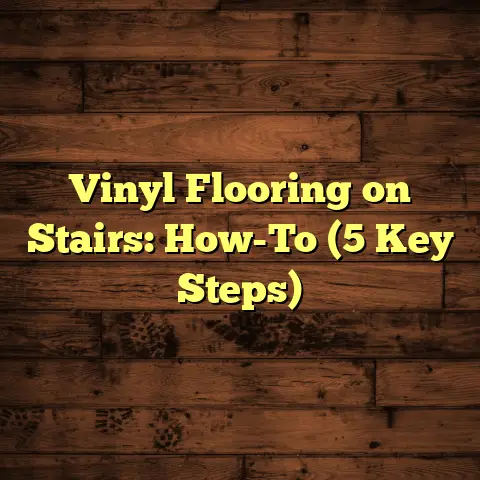Can Roomba Clean All Floors? (2 Motor Killers!)
(2 Motor Killers!)
I’m a flooring contractor, and I’ve seen it all – the good, the bad, and the downright ugly when it comes to floors.Lately, I’ve been getting tons of questions about robotic vacuums, especially Roombas. Everyone wants to know: can these little guys really handle all types of flooring?
Well, the short answer is…it’s complicated. We’re all trying to be more eco-conscious, right? That means finding ways to keep our homes clean without wasting a ton of energy or using harsh chemicals.
Robotic vacuums like the Roomba seem like the perfect solution. They’re designed to save you time and create a cleaner, more sustainable home.
But here’s the thing: while Roombas are super versatile and convenient, they’re not universally effective.
Think of it like this: you wouldn’t use the same brush to paint a tiny model car and a huge wall, would you? Different jobs need different tools.
That’s why I’m writing this article. I want to break down exactly what Roombas can and can’t do, especially when it comes to different types of floors.
We’ll dive into how these robots work, what floors they love, and – most importantly – the two types of flooring that can seriously mess up your Roomba’s motor.
Ready to get started? Let’s jump in!
Here’s what we will cover: * Roomba Technology: Understanding how Roombas work. * Flooring Types & Performance: How Roomba performs on hard surfaces, carpets, and problematic floors. * Maintenance Tips: Keeping your Roomba in top shape.
Section 1: Overview of Roomba Technology
Okay, so what makes these little robots tick? It’s more than just a vacuum attached to a Roomba. It’s actually pretty clever.
Sensors & Navigation
Roombas use a bunch of sensors to “see” their surroundings. These sensors help them avoid obstacles, navigate around furniture, and even detect stairs to prevent a tumble.
Some models even have cameras that create a map of your home, allowing for more efficient cleaning.
Suction Mechanisms
The suction power of a Roomba is crucial for picking up dirt, dust, and debris. Different models have different suction capabilities, measured in Pascals (Pa).
Higher Pa means more suction, which is especially important for carpets. I’ve seen models range from around 600 Pa to over 2500 Pa. That’s a big difference!
Brush Systems
Most Roombas use a combination of brushes to loosen dirt and sweep it into the suction path. These brushes are designed to work on various surfaces, but some are better suited for carpets while others excel on hard floors.
For example, some models have rubber brushes that are great for grabbing pet hair on hardwood, while others use bristle brushes for agitating carpet fibers.
Different Models, Different Features
iRobot, the company that makes Roomba, offers a range of models with varying features and price points.
- Entry-Level Models: These are your basic Roombas, great for small apartments and light cleaning.
- Mid-Range Models: These offer more advanced features like app control, scheduled cleaning, and stronger suction.
- High-End Models: These are the top-of-the-line Roombas with features like smart mapping, automatic dirt disposal, and even self-emptying dustbins.
Understanding these features is key to choosing the right Roomba for your specific flooring needs.
For example, if you have mostly hardwood floors, you might not need a super powerful model with all the bells and whistles. But if you have thick carpets and pets, you’ll want something with stronger suction and more robust brushes.
Section 2: Types of Flooring and Roomba Performance
Now, let’s get to the heart of the matter: how do Roombas perform on different types of floors?
Subsection A: Hard Surfaces
(Tile, Hardwood, Laminate)
Hard surfaces are generally a Roomba’s best friend. Tile, hardwood, and laminate floors are smooth and relatively easy to clean.
Suction Power on Hard Surfaces
On hard surfaces, a Roomba’s suction power is very effective at picking up loose debris, dust bunnies, and even pet hair. The brushes help sweep the dirt into the suction path, leaving your floors clean and shiny.
I’ve seen Roombas do a great job on hardwood floors, especially with models that have rubber brushes designed to grab pet hair without scratching the surface.
User Testimonials & Expert Opinions
I’ve talked to tons of homeowners who swear by their Roombas for keeping their hard floors clean. They love the convenience of being able to schedule cleanings and come home to sparkling floors.
However, some people have mentioned that Roombas can sometimes struggle with larger debris or sticky messes on hard surfaces. In those cases, a quick spot clean with a mop might be necessary.
Table: Roomba Performance on Hard Surfaces
| Flooring Type | Roomba Performance |
|---|---|
| Tile | Excellent |
| Hardwood | Excellent |
| Laminate | Excellent |
Subsection B: Carpets and Rugs
Carpets are where things get a little more complicated. The effectiveness of a Roomba on carpets depends on several factors, including the carpet’s pile height, material, and density.
Roomba Capabilities on Carpeted Surfaces
On low-pile carpets, Roombas generally perform well. The brushes can agitate the fibers and the suction can lift dirt and debris. However, on plush or shag carpets, Roombas can struggle.
Challenges on Plush or Shag Carpets
The thick fibers of plush carpets can create too much resistance for the Roomba’s brushes, slowing it down or even causing it to get stuck.
Shag carpets, with their long, loose fibers, are even more problematic. The Roomba’s brushes can get tangled in the fibers, leading to operational issues and potential motor damage.
Brush Systems and Suction on Carpets
Roombas with stronger suction and more powerful brushes are better equipped to handle carpets. Models with adjustable brush heights can also adapt to different carpet types.
However, even the best Roombas may not be able to completely replace a traditional vacuum cleaner on carpets, especially for deep cleaning or stain removal.
User Experiences
I’ve heard mixed reviews from Roomba users with carpets. Some people are thrilled with how well their Roombas clean their carpets, while others are disappointed with the results.
One common complaint is that Roombas can leave lines on carpets, especially on high-pile carpets. This is because the brushes can flatten the fibers in one direction.
Table: Roomba Performance on Carpets
| Carpet Type | Roomba Performance |
|---|---|
| Low-Pile | Good |
| Medium-Pile | Average |
| High-Pile | Poor |
| Shag | Very Poor |
Subsection C: Problematic Flooring Types
(Highlighting 2 Motor Killers!)
Okay, now let’s talk about the flooring types that can actually damage your Roomba. I’m talking about the two motor killers!
1. Thick Plush Carpets
As I mentioned earlier, thick plush carpets can be a real challenge for Roombas. The density of the fibers creates a lot of resistance, which can strain the Roomba’s motors.
Over time, this can lead to motor failures or decreased efficiency. I’ve seen cases where Roomba motors have burned out after being used regularly on thick plush carpets.
Why Thick Plush Carpets are Bad:
- Increased Resistance: The dense fibers create a lot of friction, making it harder for the Roomba to move and clean.
- Motor Strain: The increased resistance puts extra strain on the Roomba’s motors, leading to premature wear and tear.
- Reduced Suction: The thick fibers can block the suction, making it harder for the Roomba to pick up dirt and debris.
2. Fringe or Loose Rugs
Fringe and loose rugs are another major hazard for Roombas. The loose threads and fringes can easily get caught in the Roomba’s brushes, causing operational issues and potential motor damage.
I’ve seen cases where Roomba brushes have become completely tangled in fringe, causing the motor to overheat and fail.
Why Fringe and Loose Rugs are Bad:
- Brush Entanglement: The loose threads and fringes can easily wrap around the Roomba’s brushes, causing them to stop spinning.
- Motor Overload: When the brushes get tangled, the motor has to work harder to try to turn them, leading to overheating and potential damage.
- Navigation Issues: The tangled fringe can also interfere with the Roomba’s navigation, causing it to get stuck or move erratically.
Case Studies & Anecdotal Evidence
I’ve heard countless stories from Roomba users who have encountered problems with these flooring types.
One woman told me that her Roomba completely died after she used it on a thick shag rug. The motor burned out, and she had to replace the entire unit.
Another person said that their Roomba constantly got stuck on the fringe of their area rug. They had to spend several minutes untangling the brushes every time the Roomba cleaned.
These stories highlight the real risks involved in using Roombas on these types of floors.
Section 3: Maintenance and Care Tips for Roomba Users
Okay, so how can you keep your Roomba running smoothly and avoid those motor killers? Regular maintenance is key!
Importance of Regular Maintenance
Just like any other appliance, your Roomba needs regular maintenance to ensure optimal performance and longevity. This is especially important when using your Roomba on various flooring types, as different surfaces can create different challenges.
Detailed Maintenance Tips
Here are some detailed maintenance tips to keep your Roomba in top shape:
-
Empty the Dust Bin Regularly: This is the most basic maintenance task, but it’s also one of the most important. A full dust bin can reduce suction power and cause the Roomba to leave dirt behind. I recommend emptying the dust bin after every cleaning cycle, or at least once a week.
-
Clean the Brushes: The brushes are responsible for agitating dirt and debris, so it’s important to keep them clean. Remove any tangled hair, strings, or other debris from the brushes regularly. You can use a small brush or your fingers to remove the debris.
-
Check for Tangled Hair or Debris in the Motors: This is especially important if you have pets. Tangled hair or debris can put extra strain on the motors, leading to overheating and potential damage. Check the motors regularly and remove any obstructions.
-
Replace the Filters: The filters help trap dust and allergens, keeping your home clean and healthy. Replace the filters every few months, or more often if you have pets or allergies.
-
Clean the Sensors: The sensors help the Roomba navigate and avoid obstacles. Wipe the sensors clean with a soft cloth regularly to ensure they are working properly.
Using Roomba According to Guidelines
It’s also important to use your Roomba in accordance with the manufacturer’s guidelines. This means following the instructions in the owner’s manual and avoiding using the Roomba on flooring types that are not recommended.
Table: Roomba Maintenance Schedule
| Task | Frequency |
|---|---|
| Empty Dust Bin | After Each Cycle |
| Clean Brushes | Weekly |
| Check Motors | Monthly |
| Replace Filters | Every 2-3 Months |
| Clean Sensors | Monthly |
Section 4: Conclusion
So, can Roomba clean all floors? As you can see, the answer is not a simple yes or no. While Roombas are incredibly convenient and can be effective on many flooring types, they are not universally suitable for all surfaces.
Roombas perform best on hard surfaces like tile, hardwood, and laminate. They can also do a decent job on low-pile carpets, but they may struggle on plush or shag carpets.
And, as we discussed, certain flooring types like thick plush carpets and fringe rugs can actually damage your Roomba’s motors.
Key Points
- Roombas are convenient but not universally effective.
- Hard surfaces are generally a Roomba’s best friend.
- Carpets can be challenging, especially plush or shag.
- Thick plush carpets and fringe rugs can damage Roombas.
- Regular maintenance is crucial for optimal performance.
Reinforcing the Idea
Ultimately, the key to maximizing the longevity and effectiveness of your Roomba is to be aware of the specific challenges posed by different flooring types.
By understanding your flooring and following the maintenance tips I’ve shared, you can help your Roomba stay in top shape for years to come.
Call to Action
Before you buy a Roomba or use it on a particular type of flooring, take a moment to consider your flooring types and the Roomba’s specifications.
Read the owner’s manual carefully and follow the manufacturer’s recommendations. And if you’re unsure whether a particular flooring type is safe for your Roomba, it’s always better to err on the side of caution.
Happy cleaning!





